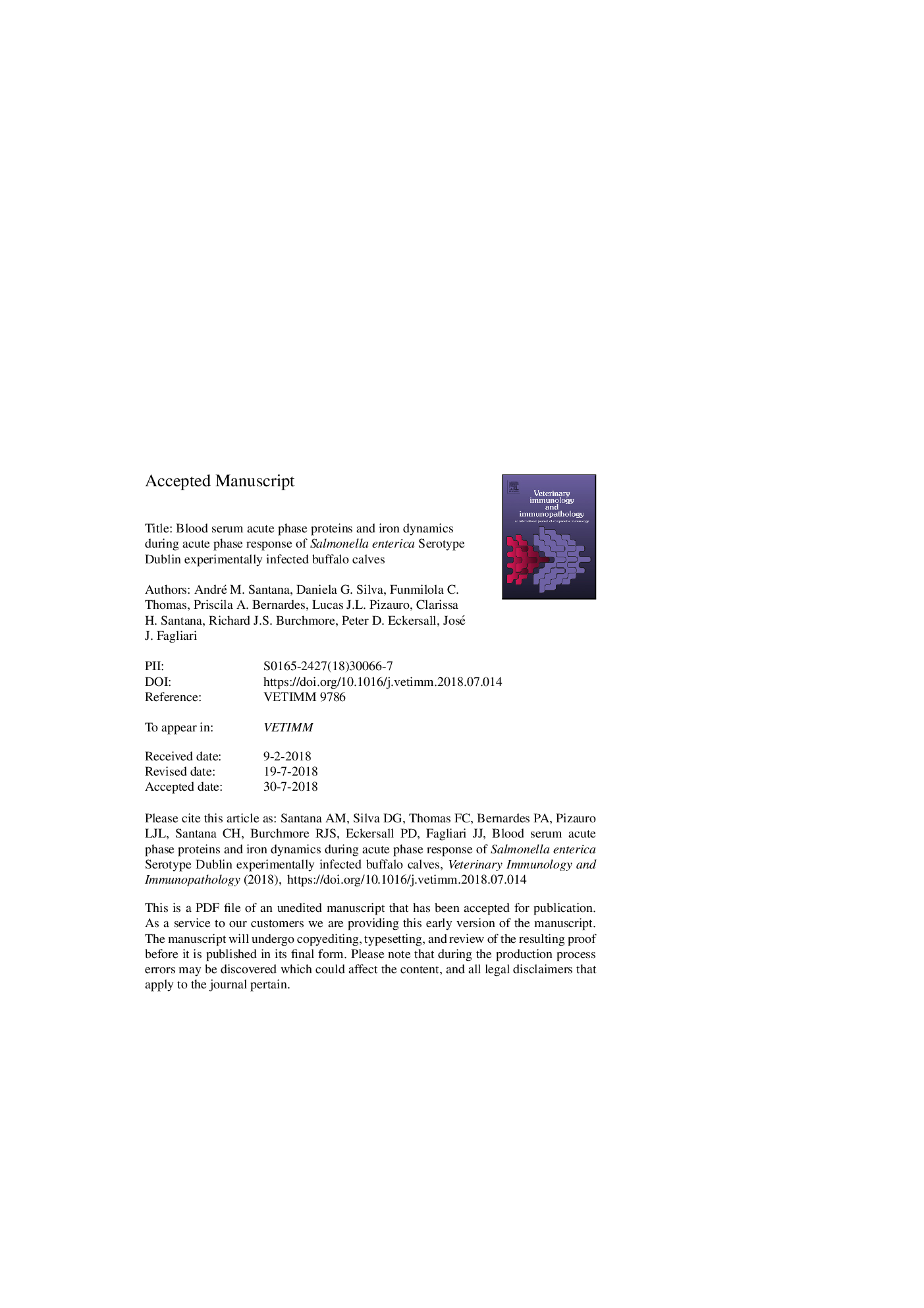| کد مقاله | کد نشریه | سال انتشار | مقاله انگلیسی | نسخه تمام متن |
|---|---|---|---|---|
| 8504648 | 1554982 | 2018 | 36 صفحه PDF | دانلود رایگان |
عنوان انگلیسی مقاله ISI
Blood serum acute phase proteins and iron dynamics during acute phase response of Salmonella enterica serotype Dublin experimentally infected buffalo calves
دانلود مقاله + سفارش ترجمه
دانلود مقاله ISI انگلیسی
رایگان برای ایرانیان
کلمات کلیدی
موضوعات مرتبط
علوم زیستی و بیوفناوری
علوم کشاورزی و بیولوژیک
علوم دامی و جانورشناسی
پیش نمایش صفحه اول مقاله

چکیده انگلیسی
The study aimed to evaluate clinical signs, blood serum acute phase proteins (APP) and iron dynamics during the acute phase response (APR) of Salmonella Dublin experimentally infected Murrah buffalo calves. Six buffalo calves constituted the control group (CNT) and six were orally inoculate with 108 CFU of S. Dublin (INF). Clinical evaluation was performed, rectal swabs to detect S. Dublin strains were collected and venous blood was sampled before and throughout seven days after inoculation. The APP fractions β-haptoglobin, α-haptoglobin, ceruloplasmin and transferrin were analyzed by 1-D and 2-D electrophoresis. Proteins were identified using LC/ESI-MS/MS and NCBI database. Plasma fibrinogen, serum iron and serum haptoglobin concentrations were measured. The inoculation of 108 CFU of S. Dublin was effective in inducing clinical signs of Salmonellosis, such as hyperthermia and diarrhea. 1-DE showed that β and α-haptoglobin increased 204% (pâ=â0.008) and 184% (pâ=â0.022) 48âh after inoculation (HAI), respectively, with highest concentrations 120 HAI (498% increased, pâ=â0.012; 431% increased, pâ=â0.011) and 168 HAI (492% increased, pâ=â0.019; 523% increased, pâ=â0.028). 2-DE showed that the expression of two spots, identified as β-haptoglobin, were increased 693% (pâ=â0.0006) and 580% (pâ=â0.0003) 168 HAI, respectively, while one spot, identified as α-haptoglobin, increased 714% (pâ=â0.040). Haptoglobin concentrations increased 1339% (pâ<â0.0001) 168 HAI. 1-DE showed that ceruloplasmin increased 42% (pâ=â0.034) 48 HAI, with highest concentration 120 HAI (133% increased, pâ=â0.022). 2-DE showed that the expression of two spots, identified as ceruloplasmin, were increased 218% (pâ=â0.0153) and 85% (pâ=â0.0143) 168 HAI, respectively. Fibrinogen increased 78% (pâ=â0.012) 96 HAI, with highest concentration 120 HAI (increased 114%, pâ=â0.002). Iron decreased 33% 24 HAI (pâ=â0.015) and 37% 72 HAI (pâ=â0.029), and began to be restored 96 HAI. 1-DE showed that transferrin decreased 23% 120 HAI (pâ=â0.047), and that values were restored 168 HAI. 2-DE showed that expression patterns of transferrin comparing 0âh and 168 HAI were similar, evidencing that values were restored 168 HAI. In conclusion, the inoculation of 108 CFU was effective in inducing hyperthermia and diahrrea. β and α-haptoglobin, ceruloplasmin and fibrinogen worked as positive APP during the APR to S. Dublin infection and are potential biomarker candidates. Concentrations of iron and transferrin decreased during the infection, highlighting the fact that mechanisms for restricting iron availability are part of the APR triggered against S. Dublin infection in buffalo calves.
ناشر
Database: Elsevier - ScienceDirect (ساینس دایرکت)
Journal: Veterinary Immunology and Immunopathology - Volume 203, September 2018, Pages 30-39
Journal: Veterinary Immunology and Immunopathology - Volume 203, September 2018, Pages 30-39
نویسندگان
André M. Santana, Daniela G. Silva, Funmilola C. Thomas, Priscila A. Bernardes, Lucas J.L. Pizauro, Clarissa H. Santana, Richard J.S. Burchmore, Peter D. Eckersall, José J. Fagliari,